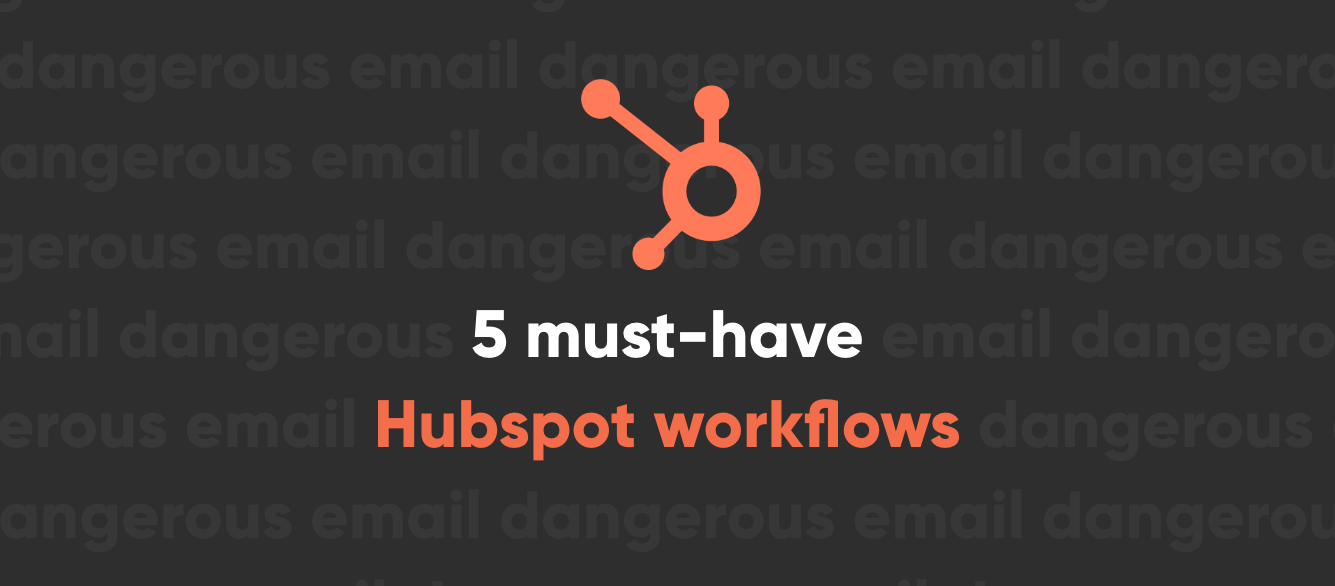
5 must-have HubSpot workflows

In traditional marketing and sales cycles, lead-nurturing was a process littered with quick-touch phone calls, thank you cards, and fruit baskets, all of which amounted to a lot of menial work and consumed time.
With the rise of digital marketing, these steps have made way for marketing automation workflows, which allow businesses to reach and engage with prospects and customers with minimal recurring effort.
There are numerous platforms marketers can leverage out there to facilitate their marketing automation efforts, and HubSpot is certainly an industry leader. Not only does HubSpot serve as a robust CRM and informational resource, but it also affords marketers the ability to create detailed workflows to reach users at the right time and in the right way.
Here is a closer look at five HubSpot workflows that can revolutionize your sales funnel to drive new business and retain loyal customers with a fraction of the effort of manual marketing tasks.
What is a HubSpot workflow?
Workflows in HubSpot are a marketing automation tool that allows you to streamline marketing and sales processes to take certain manual tasks off your plate and to keep your offers and messaging in front of the right users at the right times.
Workflows allow you to automate email, SMS, and website communication based on specific triggers users take within your digital platforms. Workflows automate actions on your contacts, companies, deals, quotes, and tickets. When you sign up for a newsletter and receive a thank you or welcome email, that’s a workflow in action. The signup is the trigger and the subsequent message is the resulting action.
There are many different types of workflows in HubSpot, but there are five we’d like to highlight as being particularly impactful for digital marketers. Let’s take a look.
1. Lead Nurture Workflows
Lead nurture workflows help you keep in touch with prospects after they first interact with your brand, increasing your presence in their minds and increasing the likelihood that they will one day convert.
Lead nurture workflows can take action:
- After content downloads and form submissions – This is the simplest and most necessary lead nurture workflow, with the purpose of engaging with leads immediately after they first interact with your brand and then keeping them engaged moving forward.
- Based on a lead’s activity – HubSpot allows you to trigger lead nurture workflows for existing contacts based on their website page visits. This is particularly useful for pages like a “Contact Us” page, a specific product page, or any other page that signals a lead with high intent.
- For lead scoring – You are also able to assign positive and negative scores to actions contacts take in emails and on your website. If a contact takes an action that makes them a more or less qualified lead, an email could be automatically sent to them. An alert could also be sent to a sales rep to remind them to follow up with that lead.
2. Reengagement Workflows
Reengagement workflows are meant to reach back out to users who have already interacted with your brand – but not for a while. You can establish these workflows to reach out to users based on your own criteria of them being unengaged, such as not opening an email, not visiting your website, or not converting after a certain number of days.
Reengagement workflows include:
- Marketing reengagement series – Contacts that haven’t engaged with your website or marketing emails in a while can be sent a promo email or a new piece of content to catch their attention and bring their focus back to your brand, such as an eBook, guide, or checklist.
- Sales reengagement series – Similar to a lead nurturing series, when a contact becomes a less-qualified lead, an internal alert can be sent to sales rep to remind them to follow up with that individual.
3. Welcome Workflows
Welcome workflows allow you to funnel new contacts into specific email and customer lists. They can help you identify what a contact is interested in and can also send them a welcome email to tap into those interests. Welcome workflows also allow your sales team to see new customers as they come in and to change their lead status once onboarded.
4. Abandonment Workflows
Sometimes users begin down the path of completing a purchase or submitting a form and then get cold feet. It happens. But when it does happen, abandonment workflows are among the best ways to reel them back in and get them to complete the process.
Types of abandonment workflows include:
- Abandoned cart – When someone adds items to their cart from your ecommerce site but doesn’t check out or complete the purchase, an automated follow-up email can inspire them to do so. An automated step can also be triggered to assign a sales rep to that contact to follow up personally.
- Abandoned form – This is the same concept as an abandoned cart workflow, but with a form submission. This workflow can send a marketing email to inspire the contact to complete the form or can automatically assign a sales rep to that contact to follow up.
5. Task-Assigning Workflows
More on the internal side, task-assigning workflows help keep tasks organized and assigned to the correct team or person. For example, depending on what stage a deal is in, the workflow can assign tasks to certain people until the deal is closed. You can also trigger tasks to be created based on specific actions taken in each stage of a deal.
Start driving qualified leads with less effort with help from Perrill
Since our conception as Minneapolis’s first digital agency in 1993, Perrill has grown into one of the most experienced and capable SEO experts in the Midwest. We use sustainable strategies, high-value keywords, and proven tactics to position you at the top of search results and make sure you say there.





